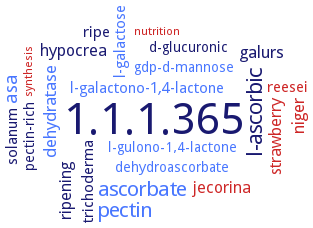1.1.1.365: D-galacturonate reductase
This is an abbreviated version!
For detailed information about D-galacturonate reductase, go to the full flat file.

Word Map on EC 1.1.1.365 
-
1.1.1.365
-
l-ascorbic
-
pectin
-
ascorbate
-
asa
-
galurs
-
dehydratase
-
niger
-
hypocrea
-
ripening
-
strawberry
-
jecorina
-
ripe
-
l-galactono-1,4-lactone
-
l-galactose
-
trichoderma
-
solanum
-
reesei
-
l-gulono-1,4-lactone
-
pectin-rich
-
gdp-d-mannose
-
d-glucuronic
-
dehydroascorbate
-
synthesis
-
nutrition
- 1.1.1.365
-
l-ascorbic
- pectin
- ascorbate
- asa
- galurs
- dehydratase
- niger
-
hypocrea
-
ripening
- strawberry
- jecorina
-
ripe
- l-galactono-1,4-lactone
- l-galactose
-
trichoderma
-
solanum
- reesei
- l-gulono-1,4-lactone
-
pectin-rich
- gdp-d-mannose
-
d-glucuronic
- dehydroascorbate
- synthesis
- nutrition
Reaction
Synonyms
AKR2, AnGaaA, AnGar1, Cd-GAR, D-galacturonate reductase, D-galacturonic acid reductase, D-galacturonic acid reductases, FaGalUR, gaaA, GalA reductase, galacturonate reductase, GalUR, gar1, GAR2, NADPH-dependent D-galacturonate reductase, PcGOR
ECTree
Advanced search results
Cloned
Cloned on EC 1.1.1.365 - D-galacturonate reductase
Please wait a moment until all data is loaded. This message will disappear when all data is loaded.
expressed in Arabidopsis thaliana and in Escherichia coli XL1-Blue MRF' cells
-
expressed in Solanum tuberosum via Agrobacterium tumefaciens-mediated transformation
-
gene gaaA, expression analysis in wild-type strain and in a strain overexpressing the D-galacturonic acid-specific GatA transporter
gene gaaA, recombinant expression of wild-type enzyme in Saccharomyces cerevisiae strain SiHY001
gene GalUR, recombinant overexpression in Solanum lycopersicum cv. Ailsa Craig leaves and fruits via Agrobacterium tumefaciens strain C58C1 transfection resulting in 2fold and 1.6fold increase in ascorbate level in tomato fruit and leaf, respectively, which correlates positively with FaGalUR transcriptional abundance and enzyme GalUR activity compared to wild-type plants, real-time PCR expression analysis
gene GalUR, recombinant stable overexpression in Solanum lycopersicum cv. H15 leaves and fruits using Agrobacterium tumefaciens strain EHA 105 transfection method, the pNW2300 vector, and the CaMV35S promoter. The transgenic plants show increased enzyme content and activity compared to wild-type. Semi-quantitative RT-PCR expression analysis, increased ascorbic acid content is correlated with high level of transcript expression, that is 2-3fold increased compared to wild-type
gene GalUR, recombinant stable overexpression in Solanum lycopersicum cv. Zhongshu 4 leaves and fruits via Agrobacterium tumefaciens strain C58C1 transfection method using the pCB302-3 vector and CaMV 35S promoter, reverse transcriptase-PCR expression analysis. The transgenic plants show 2.2-2.5fold increased enzyme activity compared to wild-type
gene GAR1, DNA and amino acid sequence determination and analysis, functional recombinant expression in Saccharomyces cerevisiae strain IFO 10455 from a genome integrated copy, integration of the pGK406GAR1 plasmid into the ura3 allele of the IFO 10455 genome, subcloning in Escherichia coli strain DH5alpha
HV538330
gene gar1, recombinant expression of wild-type and mutant enzymes in Saccharomyces cerevisiae strain SiHY001, real-time PCR expression analysis
ORF FaGalUR is recombinantly expressed in Solanum lycopersicum from plasmid pPGGUSI, which contains a 4.8 Kb promoter fragment of the polygalacturonase (PG) gene and its terminator, or from a plasmid containing the 35S CaMV promoter, mobilized from Escherichia coli by triparental mating, via Agrobacterium tumefaciens strain LBA4404 in tomato plants, PCR expression analysis. FaGalUR expression driven by the CaMV 35S promoter causes the expression of the gene in most parts of the plants, while in the second, FaGalU, is expressed under the control of the tomato fruit ripening-specific PG promoter. All of the transgenic lines are morphologically indistinguishable over different generations from control lines both in vegetative traits, such as leaf size or plant height, and fruit traits such as color or size. The majority of transgenic plants display a slight increase in fruit yield, up to 1.4fold, which is a consequence of an increase in the number of fruits rather than an increase in fruit weight. No significant changes in soluble solids of transgenic plants, but a reduction in acidity
quantitative real-time PCR enzyme expression analysis in Actinidia eriantha cv. White
-


 results (
results ( results (
results ( top
top





